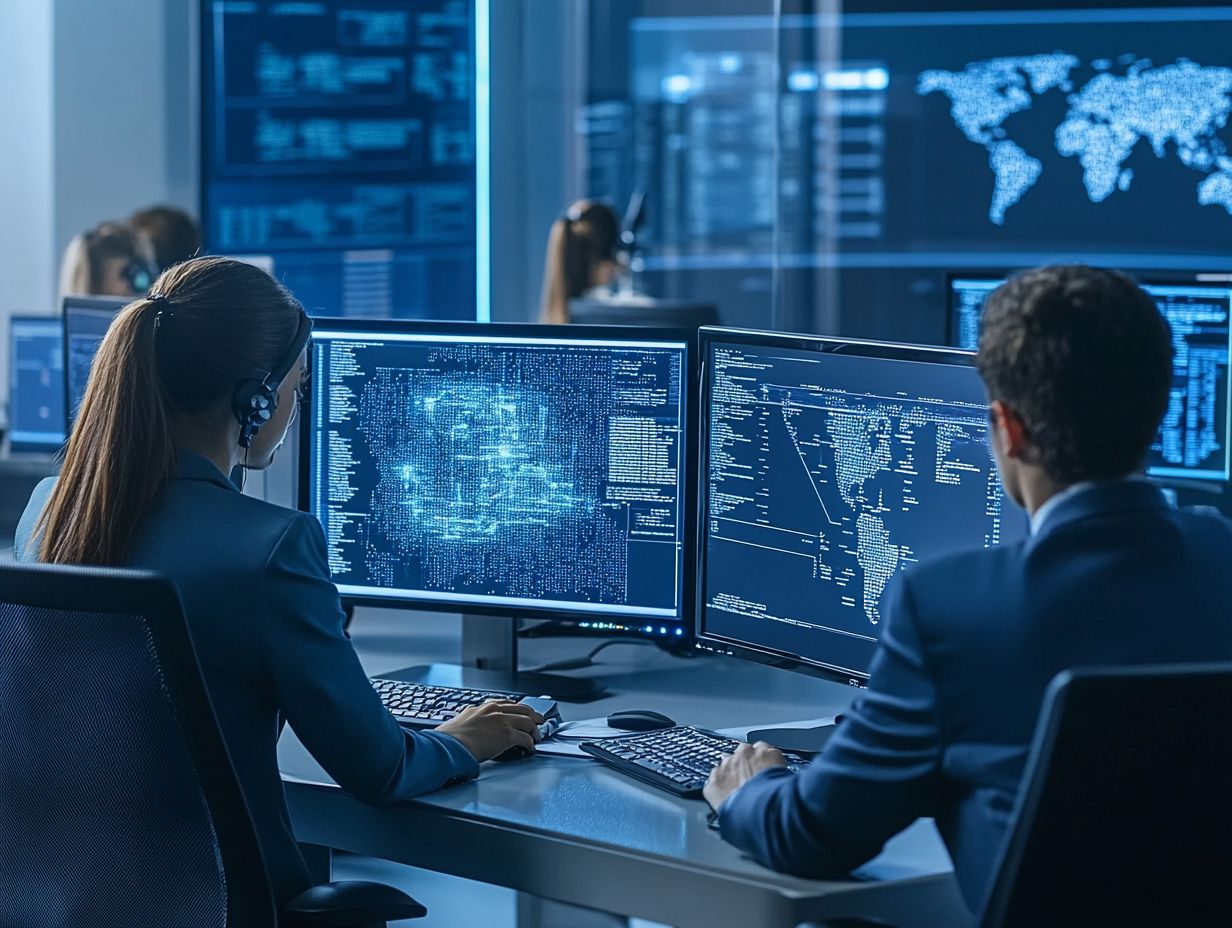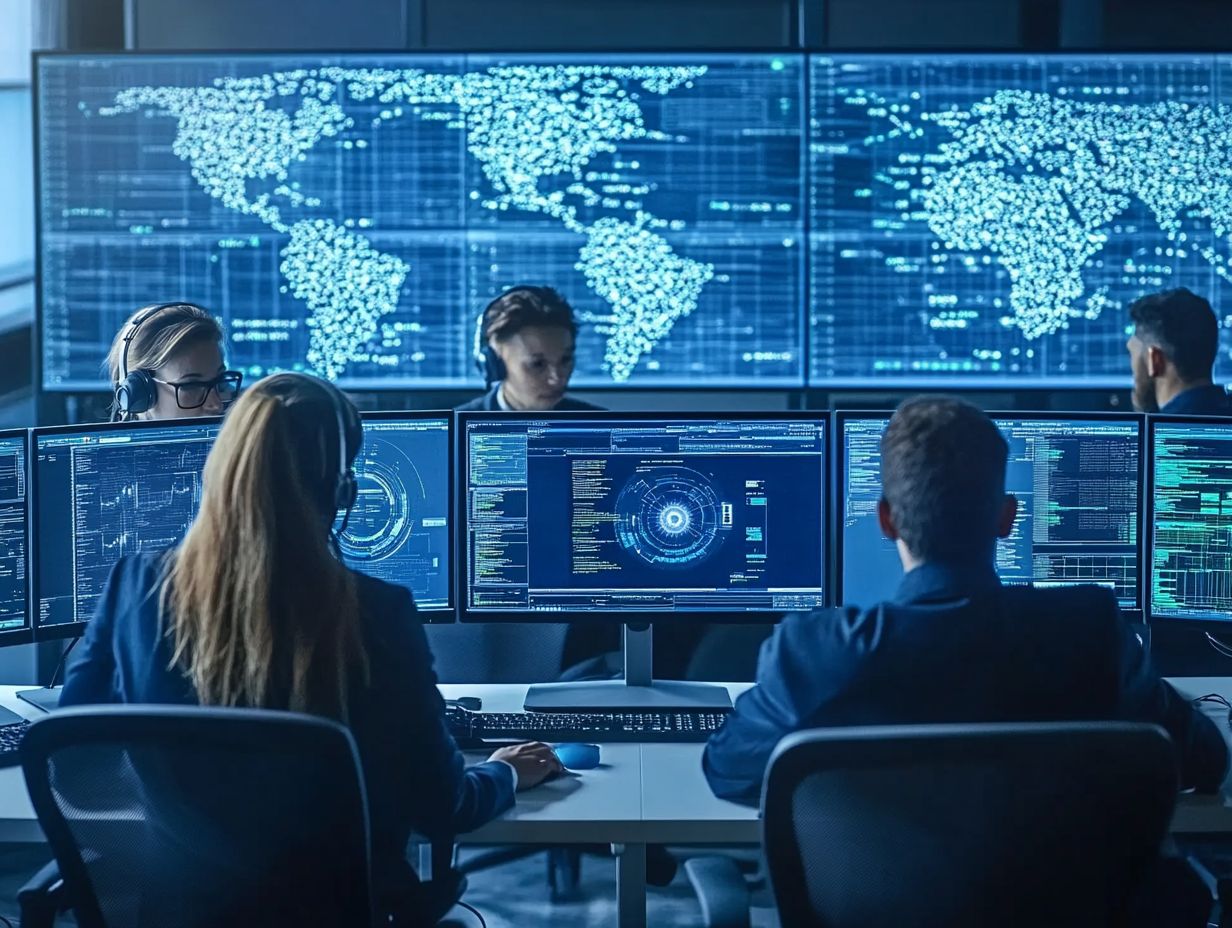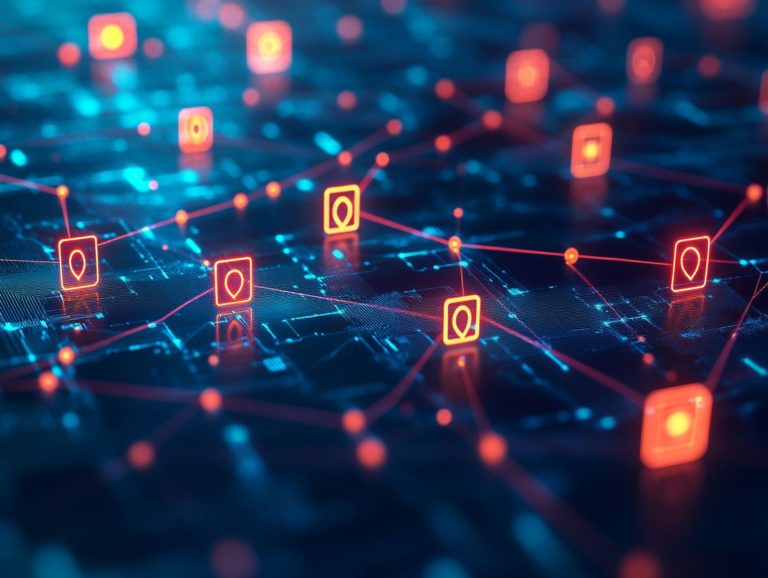5 benefits of real-time monitoring in managed security
In today’s fast-paced digital landscape, the necessity for robust security measures is more critical than ever.
Real-time monitoring has emerged as a game-changer in managed security, providing you with the ability to detect and respond to threats instantly.
This article delves into five key benefits of real-time monitoring, including immediate threat detection, enhanced compliance, and increased efficiency. You ll also learn how this technology operates, the various types available, and how even small businesses can harness its advantages while navigating potential challenges.
Dive in to discover how real-time monitoring can bolster your security strategy and keep your organization safeguarded against cyber threats.
Contents
- Key Takeaways:
- 1. Provides Immediate Detection and Response to Threats
- 2. Allows for Real-Time Analysis and Reporting
- 3. Increases Efficiency and Productivity
- 4. Enhances Compliance and Risk Management
- 5. Offers Proactive Protection Against Cyber Attacks
- What Is Real-Time Monitoring in Managed Security?
- How Does Real-Time Monitoring Work?
- What Are the Key Features of Real-Time Monitoring?
- What Are the Different Types of Real-Time Monitoring?
- How Can Real-Time Monitoring Benefit Small Businesses?
- What Are the Potential Challenges of Real-Time Monitoring?
- How Can a Business Implement Real-Time Monitoring?
- What Are the Costs Associated with Real-Time Monitoring?
- How Can Real-Time Monitoring Be Used in Conjunction with Other Security Measures?
- What Are the Future Developments in Real-Time Monitoring Technology?
- Frequently Asked Questions
- What is real-time monitoring in managed security?
- What are the benefits of real-time monitoring in managed security?
- How does real-time monitoring improve threat detection and response time?
- Can real-time monitoring help with compliance requirements?
- Is real-time monitoring suitable for all businesses?
- Are there limitations to real-time monitoring?
Key Takeaways:

Real-time monitoring in managed security allows for immediate detection and response to threats, reducing the risk of serious cyber attacks. By providing real-time analysis and reporting, businesses can quickly identify and address vulnerabilities. For more information, check out these 5 reasons to invest in managed security services before they escalate into larger issues.
Implementing real-time monitoring can increase efficiency and productivity by streamlining security processes and reducing manual tasks.
1. Provides Immediate Detection and Response to Threats
Immediate detection of threats is crucial! It empowers you to act swiftly against security incidents and potential data breaches that could compromise sensitive information.
By implementing continuous monitoring and advanced threat detection systems, you can leverage automated software to proactively address security threats before they escalate into significant issues.
Real-time monitoring allows you to identify vulnerabilities and execute incident response plans, thereby strengthening your information security practices.
In today s digital landscape, where cyberattacks are increasingly sophisticated, the significance of these measures cannot be overstated.
Organizations that continuously monitor their systems can swiftly detect unauthorized access or anomalies that signal a breach attempt.
Automated software not only accelerates response times but also facilitates the analysis of incident patterns.
This enables you to refine your defenses over time. By investing in comprehensive threat detection and response strategies, you mitigate risks while cultivating a proactive culture of security that gives the power to both employees and stakeholders.
2. Allows for Real-Time Analysis and Reporting
Real-time analysis and reporting are essential elements of effective cybersecurity practices, enabling you to continuously monitor network performance and evaluate security metrics for a swift response to any security incidents.
Track compliance metrics systematically to ensure you remain aligned with regulatory frameworks.
By integrating advanced log analysis into your systems, you can significantly enhance your ability to identify anomalies that may signal potential security threats.
This proactive approach allows for rapid investigation and remediation, effectively minimizing the impact of any possible breaches.
Compliance automation is equally vital, as it alleviates the burden of manual oversight.
This not only ensures that you consistently meet legal requirements but also builds trust and integrity with your stakeholders.
3. Increases Efficiency and Productivity
The implementation of automated software in your cybersecurity practices can significantly enhance operational efficiency and productivity by streamlining threat detection and incident response processes.
This transformation allows you to minimize the manual workloads tied to routine security tasks, empowering your teams to focus on more strategic initiatives.
For example, automated vulnerability scanning swiftly identifies and assesses potential threats across a vast network, drastically cutting down on the time you d typically spend on manual inspections.
Once these vulnerabilities are uncovered, you can leverage automated security controls to prioritize and remediate risks effectively.
This approach not only bolsters your security posture but also liberates valuable human resources, enabling your personnel to concentrate on complex problem-solving and innovative security solutions.
Ultimately, this drives higher productivity throughout your organization.
Assess your current security measures and consider implementing real-time monitoring solutions for better protection.
4. Enhances Compliance and Risk Management
Enhancing your compliance and risk management is essential in today s regulatory landscape. You must navigate various standards like HIPAA, PCI DSS, and GDPR to protect your organizational assets.
Adhering to these standards helps you avoid potential legal pitfalls and builds trust with customers and stakeholders.
A robust approach to risk assessment allows you to pinpoint weak spots within your operations, enabling you to address areas of concern proactively.
By implementing effective management strategies, you can align your practices with necessary frameworks, which may include ISO 27001 or NIST guidelines.
Investing in compliance solutions is key to streamlining your processes, automating responses to non-compliance issues, and bolstering your overall security resilience.
These solutions give you the power to navigate complex regulatory requirements, ensuring that you maintain operational integrity while safeguarding sensitive information.
5. Offers Proactive Protection Against Cyber Attacks

Proactive protection against cyber attacks is crucial for any organization, offering a defense that anticipates and responds adeptly to emerging security threats.
By utilizing threat intelligence, you can stay one step ahead of potential intrusions. Analyzing patterns and indicators of compromise enhances your overall cybersecurity posture.
Coupled with intrusion detection systems, which monitor and analyze network traffic for suspicious activities, you can effectively identify and neutralize threats before they escalate.
These technologies empower your cybersecurity team to act swiftly, underscoring the significance of robust risk mitigation strategies.
By adopting a comprehensive approach to risk management, you can significantly fortify your defenses, ensuring your organization is well-prepared for any potential cyber attack while minimizing disruptions to your operations.
What Is Real-Time Monitoring in Managed Security?
Real-time monitoring in managed security represents continuous oversight of your organization’s information security landscape. To ensure comprehensive protection, it’s crucial to consider the 5 features every managed security service should have, as this ensures that any potential security incidents are swiftly detected and addressed.
This proactive approach gives you the power to identify threats at their earliest stages, significantly mitigating the potential impact of security breaches on your operations.
By integrating various security tools and technologies, real-time monitoring enables your security teams to gather extensive data, analyze it, and respond promptly to emerging vulnerabilities.
The importance of such monitoring within managed security services is critical; it forms a vital component of a comprehensive cybersecurity strategy.
It enhances your vulnerability management by providing valuable insights that assist in prioritizing security efforts and optimizing resource allocation, thereby strengthening your organization s defenses against sophisticated attacks.
How Does Real-Time Monitoring Work?
Real-time monitoring operates by harnessing automated tools and sophisticated data analysis techniques to scrutinize network traffic continuously. This expertly identifies anomalies and potential threats through advanced intrusion detection systems.
These systems utilize cutting-edge algorithms and machine learning to analyze vast amounts of data in mere milliseconds, enabling immediate recognition of irregular patterns that might signal a security breach.
By employing a variety of data collection methods like packet sniffing and flow analysis this technology offers you a comprehensive view of the network landscape.
Such ongoing oversight is essential for effective network traffic analysis, ensuring any unusual activities are promptly flagged.
Integrating threat detection capabilities allows you not only to spot potential weak spots but also to respond swiftly to mitigate risks, thereby enhancing your overall security posture.
What Are the Key Features of Real-Time Monitoring?
Real-time monitoring has key features. These include security metrics, alert notifications, and unusual activity detection.
These components help spot potential threats quickly. They enable your security team to respond effectively.
Security metrics allow you to track performance over time, helping you identify weaknesses and areas ripe for improvement.
Unusual activity detection brings suspicious actions to light and minimizes false positives, ensuring genuine threats receive the attention they deserve.
Alert notifications act as immediate signals for security incidents, streamlining your incident management and response strategies.
Together, these features foster an active approach to security, ultimately protecting sensitive information and maintaining trust among your stakeholders.
What Are the Different Types of Real-Time Monitoring?
Different types of real-time monitoring play crucial roles in your organization s cybersecurity strategy. These include intrusion detection systems, automated vulnerability scanning, and network security monitoring.
Intrusion detection systems (IDS) actively analyze your network traffic to spot suspicious activities, alerting your security team to potential breaches before they escalate.
Automated vulnerability scanning works hand-in-hand with this, regularly assessing your systems for known weaknesses and ensuring timely patch management.
Meanwhile, network security monitoring offers continuous surveillance of your network operations, examining patterns and behaviors to quickly detect any anomalies.
When these elements come together, they form a robust security framework that empowers you to proactively detect threats and respond effectively, minimizing potential damages and safeguarding your sensitive information.
How Can Real-Time Monitoring Benefit Small Businesses?

Real-time monitoring is a game changer for small businesses. It protects your assets from threats effectively.
By implementing cost-effective tools that enable continuous observation of your networks and systems, you can instantly detect and respond to potential risks, significantly reducing the likelihood of data breaches.
This proactive approach fosters a sense of security among your employees and enhances the trust your customers place in your business.
With immediate alerts on anomalies or suspicious activities, you can prioritize your responses, ensuring that your limited resources are allocated efficiently to mitigate threats.
Ultimately, real-time monitoring empowers you to maintain a robust security posture while keeping your business competitive and viable, as highlighted in the 5 essential insights on managed security services.
What Are the Potential Challenges of Real-Time Monitoring?
Real-time monitoring offers numerous benefits, but it also presents potential challenges that you need to consider, such as resource allocation, operational efficiency, and the importance of 24/7 monitoring in managed security for managing security incidents.
Challenges can arise in many ways. You may face high costs tied to implementing advanced technological solutions, the complexities of integrating these systems into your existing infrastructure, and the pressing need for skilled personnel to manage and interpret the vast amounts of data generated.
To effectively navigate these obstacles, you might explore phased implementation strategies that facilitate gradual adoption.
Investing in training programs for your current staff can build expertise necessary to tackle these challenges.
Engaging in partnerships with technology providers can also be advantageous, as it allows you to leverage their resources and knowledge and ultimately reduces financial strain while bolstering your operational resilience.
How Can a Business Implement Real-Time Monitoring?
Implementing real-time monitoring in your business requires a well-structured approach. Start by checking your current security practices and identifying the tools you need. Make sure your personnel receive ongoing training.
Begin this journey with a thorough evaluation of your current cyber defense strategies. Analyze your strengths and weaknesses to lay a solid foundation for future actions.
Next, you’ll want to select the tools that best suit your unique needs, keeping scalability and ease of integration in mind.
Once your infrastructure is equipped with the right monitoring solutions, shift your focus to training your employees. Emphasize both the technology and best practices for maintaining vigilant security.
Continuous improvement is crucial in this process. Regularly review the effectiveness of your monitoring and adapt to emerging threats. This ensures your organization remains resilient against cyber risks.
What Are the Costs Associated with Real-Time Monitoring?
The costs associated with real-time monitoring can vary widely. They depend on the tools you choose, the scale of monitoring you need, and the resources allocated for ongoing management.
Understanding these factors is essential for any organization aiming to enhance its security infrastructure. Software options range from basic to highly sophisticated systems, each with its own price tag.
Personnel costs also play a critical role since skilled professionals are necessary to oversee these systems and respond swiftly to alerts. Regular updates and system checks can incur extra costs.
Investing wisely in comprehensive monitoring solutions today can save you from expensive security breaches tomorrow! These expenditures can reduce the risk of costly breaches and lead to significant long-term savings.
This proactive stance not only safeguards your assets but also builds consumer trust, ultimately reinforcing the integrity of your business.
How Can Real-Time Monitoring Be Used in Conjunction with Other Security Measures?
Real-time monitoring seamlessly connects with other security measures, such as incident response plans and risk management strategies. This establishes a comprehensive cybersecurity framework.
By leveraging real-time data, you can significantly enhance your organization’s ability to detect anomalies and respond swiftly to potential threats.
This synergy aids in identifying vulnerabilities and ensures your incident response teams have the crucial information needed to mitigate risks effectively.
When coupled with robust risk management strategies, real-time monitoring allows you to prioritize threats based on their potential impact. This leads to more knowledge-based decision-making.
When these elements collaborate, they create a resilient defense against cyber threats, making it increasingly challenging for adversaries to exploit weaknesses.
What Are the Future Developments in Real-Time Monitoring Technology?

Future developments in real-time monitoring technology are set to transform the landscape of cybersecurity. With advancements in AI automation, which uses artificial intelligence to perform tasks without human intervention, proactive threat detection will become more effective and efficient.
These innovations harness sophisticated algorithms to sift through vast amounts of data, pinpointing anomalies that might signal potential threats before they escalate.
As you integrate machine learning into your existing security frameworks, incident response becomes more streamlined. This significantly alleviates the workload on your human analysts.
This powerful synergy not only bolsters your security measures but also fosters adaptive learning. Your intelligence systems can evolve in response to emerging threats.
In this way, you can ensure that your organization remains one step ahead in an ever-evolving digital landscape.
Frequently Asked Questions
What is real-time monitoring in managed security?
Real-time monitoring in managed security is a continuous process. It involves tracking and analyzing security events in real time, which helps to identify and respond to security threats as they happen. For a deeper understanding, explore the top benefits of managed security services in 2024, rather than waiting for a security breach to occur.
What are the benefits of real-time monitoring in managed security?
Real-time monitoring offers five key benefits:
- Improved threat detection and quicker response times.
- Better visibility into network activity.
- Lower risk of security breaches.
- Enhanced compliance with business rules.
- Cost savings by preventing cyber attacks.
How does real-time monitoring improve threat detection and response time?
Security teams receive immediate alerts for suspicious activity. This allows for quick investigation and response to potential threats, speeding up how fast incidents are resolved.
Can real-time monitoring help with compliance requirements?
Yes! Real-time monitoring helps organizations see security events and spot vulnerabilities. This support ensures compliance with rules and helps avoid fines.
Is real-time monitoring suitable for all businesses?
Absolutely! Businesses of all sizes face security risks. Real-time monitoring can be tailored to fit the specific needs and budgets of any organization.
Are there limitations to real-time monitoring?
Real-time monitoring is effective, but it shouldn’t be the only security measure. Pair it with firewalls and antivirus software for complete protection against cyber threats.






